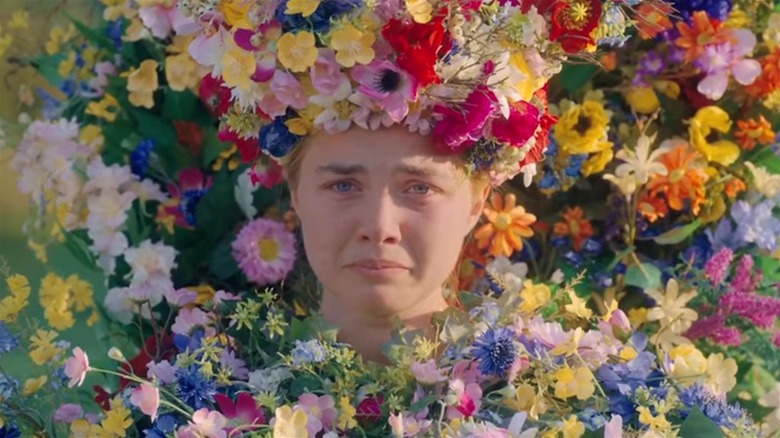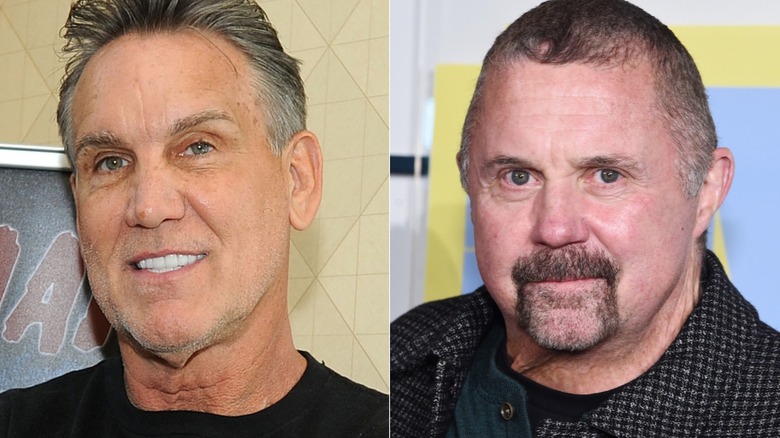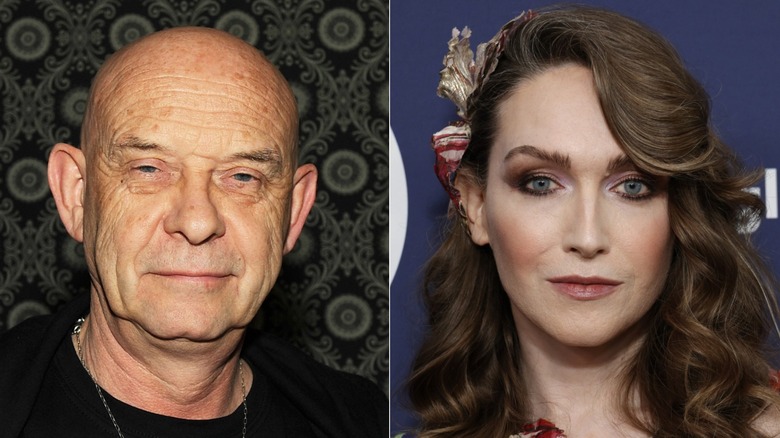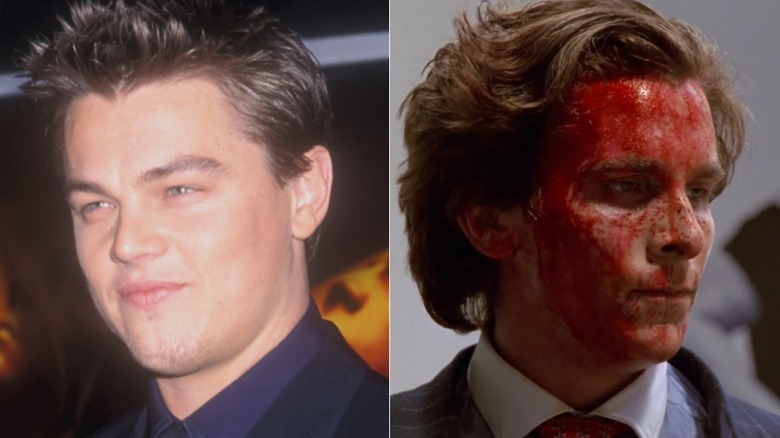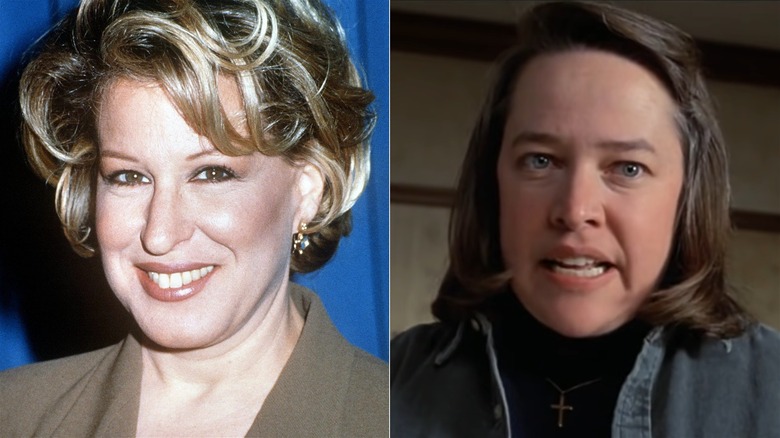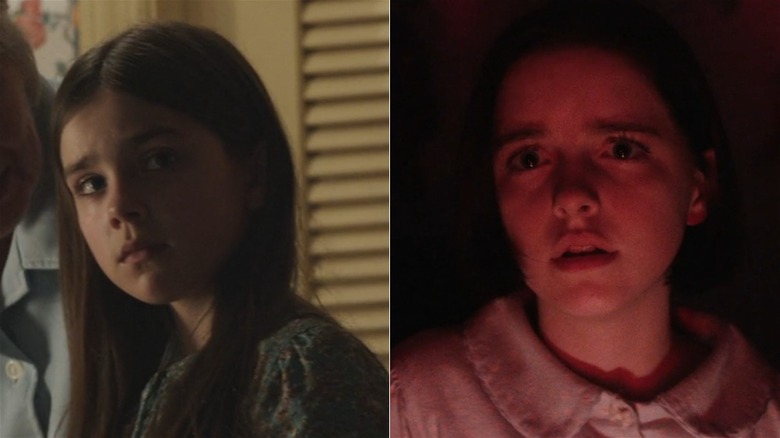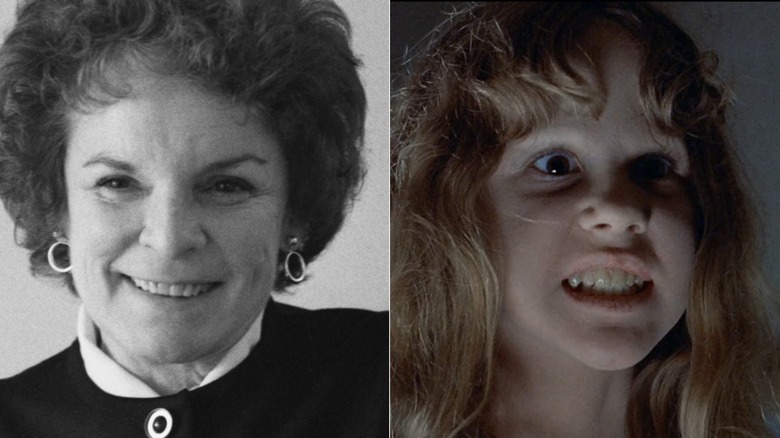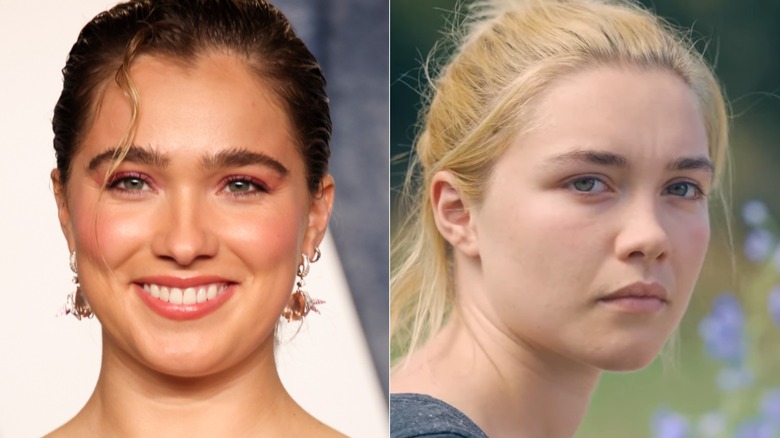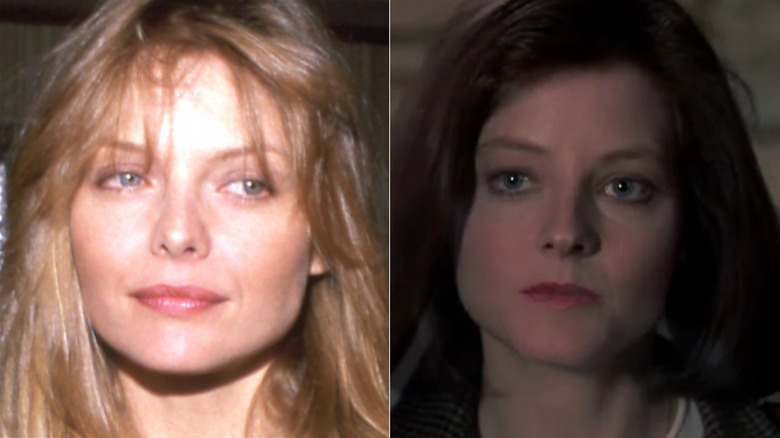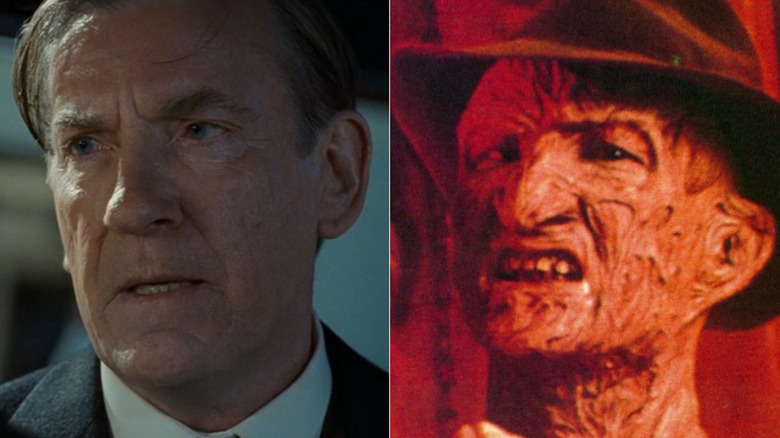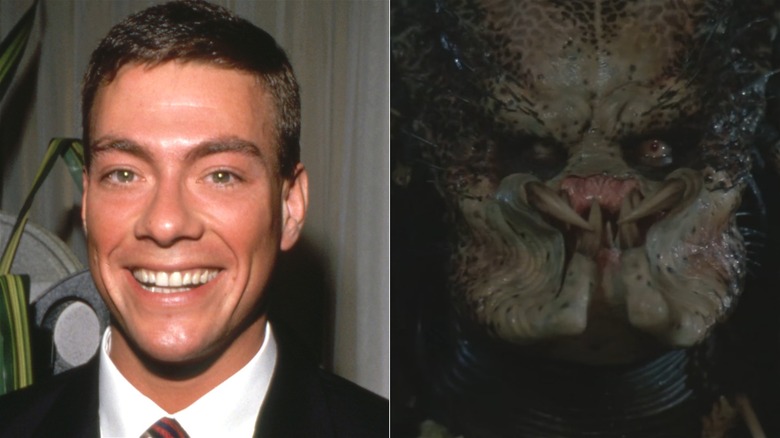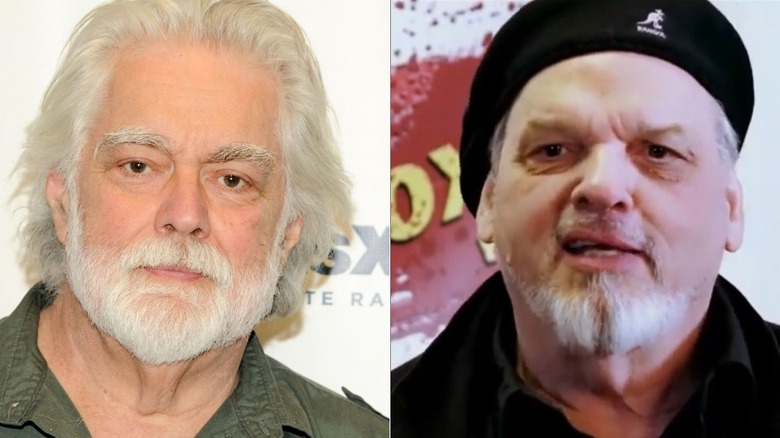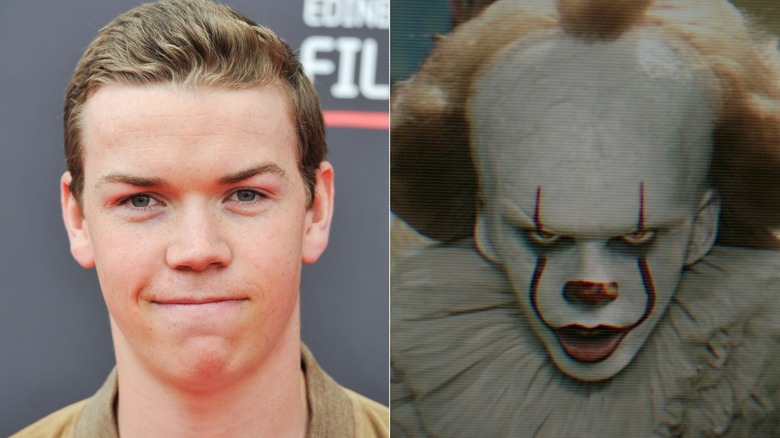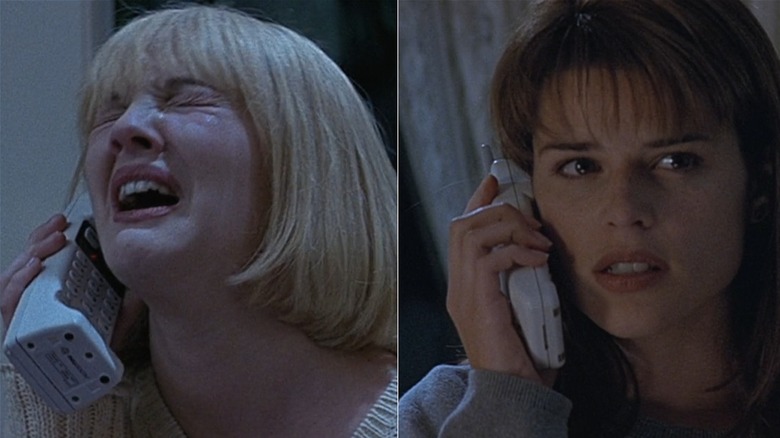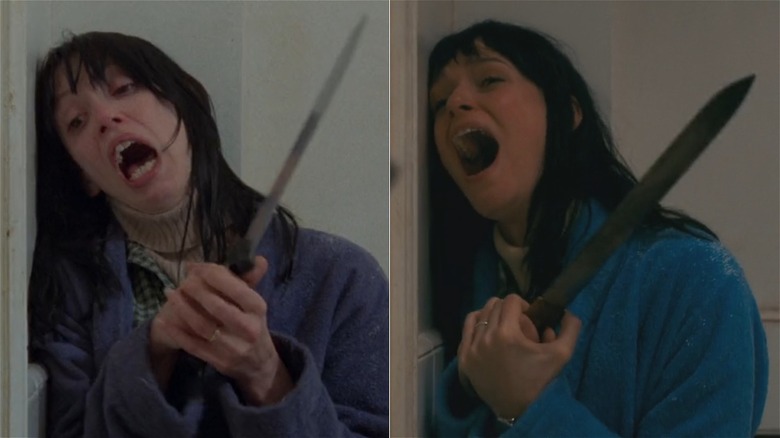Horror Actor Replacements That Were Actually For The Best
"Pearl" star Mia Goth has some thoughts on why the Academy Awards often fail to recognize standout performances in horror films. "I think that it's very political," she told Jake Hamilton (via Twitter). "I think that it's not entirely based on the quality of a project, per se." Like many horror fans, Goth wants that to change.
Horror fans love the actors who star in such films, often becoming quite devoted to them. It's not just the ones who deserve awards, either. To understand just how important all horror film performances are, one need only take a look at the talent lineup for any given horror convention. Many people are just as happy to meet someone who was killed third in a random "Friday the 13th" sequel as they are to talk to special effects artists and directors.
Sometimes, though, actors in horror films get swapped out for various reasons. A franchise has been going on for a while and the studio thinks a fresh face will juice interest in a new sequel. Actors leave a project before filming has begun — due to money, scheduling, etc. — requiring a replacement. Occasionally, actors even depart after filming has already started! Creative differences often get cited in that instance. It can be fun to imagine our favorite horror movies with other stars, but sometimes that thought experiment makes it clear that these replacements actually worked out for the best. Read on for some of our favorites.
Kane Hodder is the definitive Jason Voorhees
As is the case with many slasher franchises, several actors have portrayed Jason Voorhees. Ari Lehman was the child version of Jason in the original "Friday the 13th." Warrington Gillette (and Steve Daskawisz) took over for "Friday the 13th Part 2," the one where Jason wears a burlap sack. Richard Brooker donned the hockey mask in "Friday the 13th Part III," and then a number of actors and archive footage created the character in "The Final Chapter" and "A New Beginning." C.J. Graham took over for "Friday the 13th Part VI: Jason Lives."
While many slasher franchises replace their killers, it's not often that we get the definitive portrayal of an icon seven movies in. That's the case for "Friday the 13th," though! In "Part VII: The New Blood," Kane Hodder stepped in. He would go on to play Jason in three more films: "Jason Takes Manhattan," "Jason Goes to Hell," and "Jason X." When you think of Jason Voorhees, it's probably Hodder's brutal, animalistic version of the character who comes to mind.
Hodder told Inverse that he stood in front of a mirror and tried to figure out what new spin he could put on the character. "That's where I came up with the kind of the heaving chest," he said, "because even though he's motionless he still looks like he's about to explode." Sure enough, Hodder's Jason is a hulking force of nature, exactly what the character should've been all along.
Jamie Clayton understood her Hellraiser (2022) assignment
The so-so 2022 version of "Hellraiser" seems curiously uncomfortable with the BDSM implications of the source material, both Clive Barker's original story and the 1987 film that kicked off the franchise. The original "Hellraiser" is sadistically and sexually fascinated by bodies but the new movie feels repulsed by them, prioritizing the grotesque rather than engaging with the implications of the idea that for the Cenobites — and for some humans — pain is pleasure.
The exception? Jamie Clayton's new take on Pinhead. The "Sense8" star turned out to be a brilliant recasting choice when she assumed the character from Doug Bradley. Surprisingly, she told USA Today that she'd never even seen the original until the night before she auditioned for the remake. "I had no idea how sexy it was," she said. While some might say the filmmakers didn't really understand the source material either, Clayton got it. Her Pinhead terrifies in all the right ways, perfectly embodying the Hell Priest's threatening sensuality.
While the original Pinhead was coded as male, the team behind the 2022 remake deserves kudos for taking a chance on Clayton. As a trans actor, she told USA Today that she sometimes feels left out of certain roles. That wasn't the case this time around. "They opened the door and they allowed me in, and I was able to do what I do," she said. "And it was good."
Leonardo DiCaprio was almost Patrick Bateman
Director Mary Harron was preparing her adaptation of Bret Easton Ellis's controversial novel "American Psycho" when the studio decided Leonardo DiCaprio should play the lead role. Harron told Vice that she refused to meet with him, believing him to be all wrong for the murderous Patrick Bateman. "I knew I would find him charming, and then I would find myself getting into doing it with him," she recalled. "You have to trust your instinct, or else it's going to be a disaster." Harron feared that the script would be altered to make Bateman more sympathetic; after all, DiCaprio had just starred in "Titanic," and Harron worried his fans would expect something totally different from the psychopath she wanted to present. As a result, the studio dropped her as director.
Ultimately, DiCaprio left the project after his casting had been announced. He told The Morning Call that he hadn't even officially signed on, reasoning, "Eventually, I realized it didn't amount to anything and didn't mean anything in the end."
DiCaprio leaving the role (or, not taking the part, depending on who you believe), meant that Harron could direct it after all. She got her star, Christian Bale, and the rest is horror history. DiCaprio probably could've done something interesting, but as Harron anticipated, it would've been entirely different. Perfectly toeing the line between steely blankness and undeniable charisma, Bale's portrayal of Patrick Bateman remains one of the greatest villain performances of all time.
Bette Midler turned down the role of Annie Wilkes in Misery
Kathy Bates won a well-deserved best actress Oscar for her role as Annie Wilkes, the disturbed nurse at the heart of Rob Reiner's adaptation of Stephen King's "Misery." She's by turns sympathetic and scary, a malevolent caretaker who loves Paul Sheldon (James Caan) so much that she's willing to do anything to keep him in bed writing romance novels for her. In Bates's hands, Annie is unpredictable, terrifying Paul and audiences equally with the fact that any little thing sends her into fits of rage.
"Misery" almost turned out quite differently. A pre-"Hocus Pocus" Bette Midler was offered the part but she turned it down for a curious reason. "It was too violent," she told Variety. Okay, that one we understand; imagine Midler swinging that sledgehammer at James Caan's ankles? It'd be all wrong. However, Midler went on. "The character was so not funny, so without any qualities of redemption," Midler complained. Annie, not funny? Annie "He didn't get out of the cock-a-doodie car!" Wilkes? It's a shame Midler couldn't find the humor on the page, but Bates sure did, so it's for the best that the part went to her instead.
Mckenna Grace took over as Judy for Annabelle Comes Home
Actors sometimes get replaced through no fault of their own. Sterling Jerins played Judy Warren in "The Conjuring" and its sequel, and she proved perfectly serviceable as the daughter of Vera Farmiga and Patrick Wilson's demon-hunting duo. By the time the franchise got around to 2019's "Annabelle Comes Home," however — the third "Annabelle" spinoff film, which actually takes place shortly after the first "The Conjuring" — Jerins was simply too old to play the part again. Instead, Mckenna Grace stepped in.
In an interview with /Film, director Gary Dauberman explained, "Mckenna Grace was such a joy to work with and such a professional and a huge enormous talent and just a great collaborator, so it was necessary to replace and I was very, very fortunate and very, very happy that I found Mckenna."
Jerins may have done a solid job, but Grace is one of her generation's most promising up-and-coming talents. She's precocious yet still childlike, able to fully carry a horror film about a girl and her babysitter being terrorized by a haunted doll. "I do have a big responsibility to live up to because they're so good in all of the other films," Grace told Collider. "I'm like, 'I hope I do as good as them!'" She needn't worry; "Annabelle Comes Home" stands head and shoulders above most "Conjuring" spinoffs, thanks in large part to her performance.
Linda Blair's voice was dubbed by Mercedes McCambridge in The Exorcist
Linda Blair did a phenomenal job playing Regan MacNeil in "The Exorcist." She earned an Oscar nomination, after all. Thanks to her bravura performance (and some putrid prosthetics), Regan is a sweet girl caught up in something traumatic. Blair ably guides the character's arc from pitiful to petrifying.
Audiences may not know that Blair had help. Academy Award-winning actor Mercedes McCambridge dubbed over Regan's voice in the scenes in which the fully possessed character babbles all sorts of spooky noises. While audiences expressed concern about Blair's sanity after playing the role, it turns out they should've been worried about McCambridge instead. The "Touch of Evil" star was tortured by the things she had to make the child say, telling The New York Times, "I'm a product of 16 years of convent education, and I am still a devout Catholic, so speaking those vile blaspheming words was an agony for me."
In the same interview, McCambridge revealed that they did indeed film Blair saying the profane things that Regan squeals while possessed. "If people had heard her saying some of those obscenities, they would have fallen over laughing," McCambridge insisted. Footage of Blair's vocal performance is on YouTube, and we must give McCambridge this one: it's a good thing Blair was replaced. The resulting juxtaposition between that sweet-looking face and the grotesque voice is precisely why the movie works so well.
Haley Lu Richardson turned down Midsommar
Haley Lu Richardson stands out in films like "The Edge of Seventeen" and "Support the Girls," and her hapless assistant character Portia helps anchor the audience in the second season of "The White Lotus." She's been in comedies and historical thrillers and acted on television and in films. In short, she's got the range. Aside from a role in M. Night Shyamalan's 2016 film "Split," Richardson hasn't really dipped her toe in the horror genre.
That almost changed in 2019. Richardson told Backstage that she was considered for the leading role in Ari Aster's sun-drenched nightmare "Midsommar." Producers wanted to meet her. She turned them down, however, unwilling to do a horror film again so soon after "Split." She explained, "I just don't have it in me, going around and crying at these disturbing things. It wasn't something that I wanted, and I felt really strongly about that."
Aster subsequently tapped Florence Pugh, and horror fans should be glad he did. Richardson likely would've done a fine job, but Pugh's performance is aching, a live-wire of grief and torment. She was nominated for an Oscar for the same year's "Little Women," but if you ask us, they recognized the wrong film. It seems that Richardson knows it all worked out, too. "There was a reason I didn't have it in me," she said. "And also, Florence Pugh is just such a good actor."
Michelle Pfeiffer was offered Clarice Starling
When Jonathan Demme began preparing his adaptation of "The Silence of the Lambs," he knew exactly who he wanted to cast as Clarice Starling. Demme had just worked with Michelle Pfeiffer on "Married to the Mob," and he felt she'd be the perfect person to play the FBI agent tasked with interviewing pop culture's most notorious cannibal. He told The Daily Beast, "I felt that she could do anything." Pfeiffer, it seems, disagreed. "It was way too dark for her, so Michelle ran away from that part," Demme said.
Pfeiffer told The New Yorker much the same story. "There was such evil in that film," she said. Pfeiffer particularly hated the film's ending, which resists the good-over-evil closure one might expect from a horrific film like this. "I didn't want to put that out into the world," she said.
As Demme noted to The Daily Beast, it's a good thing Pfeiffer stepped away from the movie. Instead, they cast Jodie Foster, and the resulting performance won her an Oscar. "Working with Jodie was one of the great highs I've ever experienced working," Demme said. Her version of Clarice is a no-nonsense interrogator who can spar with Hannibal (Anthony Hopkins) like no one else. Sure, the talented Pfeiffer could have turned in a great performance herself, but if she was that uncomfortable with the storyline, it's definitely better that Foster took over.
David Warner almost played Freddy Krueger
A lot of slasher franchises recast their killers — there are several on this list! — but aside from the 2010 remake, "A Nightmare on Elm Street" villain Freddy Krueger has always been played by Robert Englund. It's a good thing, too; unlike most slashers, Freddy talks. A lot. Englund's performance toes the line between funny and frightening, making Freddy a killer who loves a killer joke as much as he loves killing. As a result, Englund gives probably the most iconic performance in slasher history.
It wasn't always going to be this way, however. "Titanic" star David Warner was originally cast as Freddy, getting far enough in the process that he sat for makeup tests later shared by Bloody Disgusting. Warner trained at the Royal Academy of Dramatic Art, and after graduating he joined the Royal Shakespeare Company. While he starred in a number of horror films — from "The Omen" to "Waxwork" — his performances tended to be reflective of his theatrical training.
It's an open question what kind of energy Warner would've brought to "A Nightmare on Elm Street." He was great at what he did, but his overall vibe is completely different than Englund's take on the character. A more stuffy, English Freddy could've been interesting, but it's hard to imagine that the character would've been nearly as memorable that way.
Jean-Claude Van Damme wasn't happy playing the Predator
We all agree that "Predator" is a slasher movie, right? The movie features a group of people being picked off one-by-one. We get multiple shots from the killer's point of view, just like in everything from "Halloween" to "Jaws." Arnold Schwarzenegger, then, is "Predator's" final girl. Call him a "scream king."
More than just a horror movie, "Predator" is a horror movie that benefited from replacing one of its leads. The late Kevin Peter Hall ultimately played the creature who stalks Arnold Schwarzenegger and friends through the jungle, and he excelled at bringing the Predator's alien physicality through, even buried under layers of prosthetics.
Originally, though, then-future action star Jean-Claude Van Damme was cast as the Predator. He even started filming. According to SFX artist Steve Johnson (via The Stan Winston School of Character Arts), Van Damme wanted to show off his martial arts skills instead of crafting an alien movement for the character. "He didn't realize that he was just kind of a stuntman, right?" Johnson recalled. "We get him out there for the first shot and he's just seething." Stuntman Peter Kent added that Van Damme complained the entire time. "After about two weeks, producer Joel Silver came to set and said, 'There's a plane ticket on your hotel bed. Get out of here.'" Van Damme leaving the film led to a redesign of the Predator suit, finally landing on the look fans know and love.
Bill Johnson's Leatherface perfectly fit The Texas Chainsaw Massacre Part 2
Tobe Hooper's original "Texas Chain Saw Massacre" ranks as one of the best slasher films ever made. The movie introduced audiences to Gunnar Hansen's Leatherface, a frightening, chainsaw-wielding cannibal who wears a mask made of human skin. The franchise that followed is... wildly inconsistent, to put it mildly. For many "TCM" fans, Hansen's version of Leatherface stands head and shoulders above the rest.
Hear us out, though: "The Texas Chainsaw Massacre Part 2" is great, and Hansen's performance simply would not have fit. Hooper directed the sequel but this time he went for laughs. The resulting movie is a campy, gleefully over-the-top gorefest that focuses on Leatherface's freakish family, the Sawyers. In Bill Johnson, Hooper found a Leatherface to match. Johnson told JoBlo that he tried to focus on the relationship between his character and his family, an approach the movie needed. "... Until one day Bubba starts creating rules for himself in contradiction to the family," Johnson explained.
There's one more touch that Johnson brought to the character. Hansen's eerie dance-like movements at the end of the first film are memorable, but so are Leatherface's pelvic thrusts in the sequel, driving home the phallic undertones of the whole chainsaw-wielding endeavor. "The 'pelvic thrust' gesture you saw in the film was created during the filming in concert with Tobe, who had lots of energy, ideas and openness to collaborating," Johnson said. We're glad Hooper had Johnson to collaborate with.
Bill Skarsgard replaced Will Poulter in the IT films
Pennywise the Clown, one of Stephen King's most disturbing creations, comes back to haunt the town of Derry, Maine, every 27 years. Fittingly, 27 years after the 1990 miniseries that starred Tim Curry, the character returned to screens once again in 2017's "IT." Will Poulter, star of "Midsommar," was originally cast as the new Pennywise. Variety announced his casting way back in 2015, when Cary Fukunaga was slated to direct that movie.
Things changed, though; this is Hollywood, after all. Eventually, Andy Muschietti replaced Fukunaga. Then, The Hollywood Reporter reported that Poulter was out, too. He'd been replaced by Bill Skarsgård. Poulter probably would've been a great Pennywise. He's tapped into darkness before, including in the "Black Mirror" episode "Bandersnatch." However, it's hard to argue that he should've had the part over Skarsgård, who turned in a deranged, instantly iconic performance in the resulting film.
Skarsgård told Collider that he found it difficult to craft his take on Pennywise until he actually settled in the makeup chair. "It was really when we did the full make-up test and see what the character would actually look like... It's a very abstract way of preparing for something when you have no idea what he will look like," Skarsgård said. It's a good thing the filmmakers were able to envision Skarsgård, because it's hard to imagine the movie without him.
Drew Barrymore was originally going to play Sidney Prescott
The opening scene of Wes Craven's "Scream" is one of the most surprising in all of horror history. Not since Janet Leigh stepped into that shower in "Psycho" have audiences been so shocked to see a star killed just as a movie gets going. Drew Barrymore's death nearly matches "Psycho's" high, telling audiences that "Scream" will be a slasher movie like no other... even as it poked fun at the genre by referencing numerous other examples of it.
However, "Scream" almost looked quite different. On "The Drew Barrymore Show," the "Firestarter" star revealed that she was originally supposed to play the lead... The actual lead, that is, not just a marketing fake-out. She was originally cast as Sidney Prescott, the part eventually portrayed by Neve Campbell. Barrymore claims that she suggested that she play Casey Becker instead. "You kind of know your hero is gonna make it," she said. "I thought, 'What if I die, and then it'll be like all bets are off. Anybody can get killed in this movie.'"
The casting shuffle worked out well. Campbell's Sidney is one of the best final girls of all time, and without the shock of seeing a big star like Barrymore die first, "Scream" may not have been as successful as it was.
Casting Alex Essoe in Dr. Sleep helped the film
Stephen King wrote "Doctor Sleep" as a direct sequel to "The Shining," following Danny Torrance in adulthood. King famously hated Stanley Kubrick's film adaptation, so "Doctor Sleep" understandably sequelizes the book rather than the movie. Writer/director Mike Flanagan, in adapting "Doctor Sleep" for the screen, smartly recognized that many audiences are more familiar with Kubrick's "Shining" than King's. In paying homage to both sources, he needed to find a way to flashback to events at the Overlook Hotel in a way that felt familiar.
Instead of using archive footage, CGI, or digitally de-aged actors, Flanagan chose to recast Danny's parents. Henry Thomas played Jack Nicholson's part, while Alex Essoe stepped in for Shelley Duvall's character, Wendy. Thomas is great — especially in the Director's Cut, which put some King back in "The Shining" — but Essoe really shines.
Her portrayal of Wendy contains elements of Duvall's unhinged interpretation, especially toward the end, when Flanagan restages shots from Kubrick's film almost exactly. At the beginning, however, Flanagan gives us a glimpse at the Torrances's lives before they reached the Overlook Hotel. Essoe's Wendy is a warm, caring mother, making her eventual shocking devolution into madness even more tragic. Recasting her was the right choice, especially as the film deals with memory, nightmare, and hallucination. She's just different enough that we can tell Danny's memory of his mother has shifted over time. It's a cool effect that wouldn't have been possible any other way.
